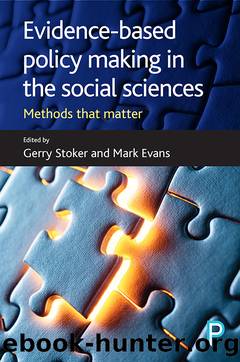Evidence-Based Policy Making in the Social Sciences: Methods That Matter by Gerry Stoker & Mark Evans

Author:Gerry Stoker & Mark Evans [Stoker, Gerry & Evans, Mark]
Language: eng
Format: epub
Tags: Political Science, Public Affairs & Administration
ISBN: 9781447329374
Google: _lL5DAAAQBAJ
Goodreads: 29362274
Publisher: Policy Press
Published: 2016-09-29T09:06:39+00:00
The main sources of âbig dataâ
The massive amounts of new information becoming available to policymakers come from two major sources:
⢠âAdministrative dataâ â a broad category including governmental records and tracking information but also data from commercial and business sources.
⢠The âdigital residuesâ â the âelectronic footprintsâ of behaviour patterns, meanings and memes â created by our contemporary civilisation.
Administrative data
A 2013 government taskforce in the UK reported on the prospects for encouraging greater use by researchers of administrative data:
Government collects and holds a vast amount of data as part of the normal transaction of government business. Similarly, government collects data for the purpose of producing statistics about the current state of the economy and society. The ability to link and analyse data held by government has the potential to add new insights to our understanding of how society and the economy performs and to reduce the need for separate data collections where we ask, for statistical purposes, for the same information that has already been provided for administrative purposes. (BIS, 2013: 4)
Following a UK government commitment to improving data-sharing, a rather complex apparatus for encouraging academic researchers to make greater use of administrative data was put in place, later on reorganised as the Administrative Data Research Network (ADRN, 2016). At first, most take-up of these new opportunities was by health researchers (perhaps 90%), followed later by education (perhaps 5%). More economics-, finance- or transport-focused applications came much later on, in part because the ADRN framework is relatively restrictive and oriented a lot towards protecting individual identities.
Administrative data in government are all collected for transactional purposes, rather than being designed from the outset as a data set for analysis by researchers (eg conducting repeat social science surveys), or forming part of the carefully constructed and evaluated national statistics reporting. Major longitudinal surveys are very expensive and large-scale social surveys, asking respondents for the same fixed grid of information over successive years. Questions have to be specified in advance. National statistics generally operate by requiring business or civil society organisations to file regular reports with government, filling in forms with numbers that are then checked and aggregated â for example, to form a picture of the latest pace of economic activity in a country.
Table 8.3 shows some pros and cons of administrative data sets against these main alternatives. Administrative data typically record objective behaviours, but not peopleâs opinions or meanings. They can often be collected unobtrusively and non-reactively (so you do not need to worry about people âfakingâ survey responses or âdressing upâ statistics to try and make them look better). However, the items recorded may not be exactly what research is interested in, but only indicators often or usually associated with what the focus of interest is.
Table 8.3: Some advantages and disadvantages of using administrative data in a âbig dataâ mode
Download
This site does not store any files on its server. We only index and link to content provided by other sites. Please contact the content providers to delete copyright contents if any and email us, we'll remove relevant links or contents immediately.
Cecilia; Or, Memoirs of an Heiress — Volume 1 by Fanny Burney(32022)
Cecilia; Or, Memoirs of an Heiress — Volume 3 by Fanny Burney(31436)
Cecilia; Or, Memoirs of an Heiress — Volume 2 by Fanny Burney(31380)
The Great Music City by Andrea Baker(30641)
We're Going to Need More Wine by Gabrielle Union(18605)
All the Missing Girls by Megan Miranda(14592)
Pimp by Iceberg Slim(13717)
Bombshells: Glamour Girls of a Lifetime by Sullivan Steve(13665)
Fifty Shades Freed by E L James(12886)
Talking to Strangers by Malcolm Gladwell(12813)
Norse Mythology by Gaiman Neil(12785)
For the Love of Europe by Rick Steves(11331)
Crazy Rich Asians by Kevin Kwan(8860)
Mindhunter: Inside the FBI's Elite Serial Crime Unit by John E. Douglas & Mark Olshaker(8664)
The Lost Art of Listening by Michael P. Nichols(7125)
Enlightenment Now: The Case for Reason, Science, Humanism, and Progress by Steven Pinker(6852)
The Four Agreements by Don Miguel Ruiz(6284)
Bad Blood by John Carreyrou(6252)
Weapons of Math Destruction by Cathy O'Neil(5800)
